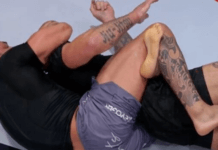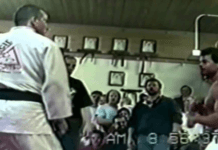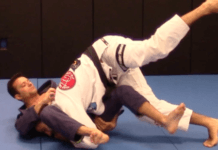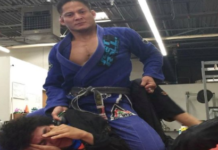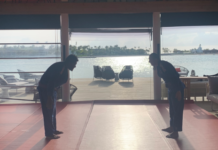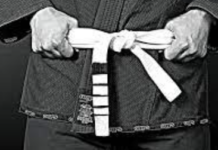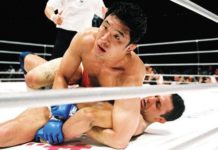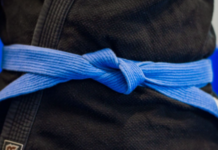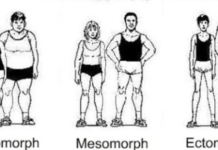There are many ways of how you can improve your BJJ game. Watching tutorial videos and crosstraining are great here. Doing some specific exercises is also awesome for improving jiu-jitsu. And pull-ups are one of these great exercises for grapplers. See below for why to do pull-ups for jiu jitsu, what are the types of pull-ups and which are best for BJJ.
Reasons to do pull-ups for jiu-jitsu
If you are wondering if pull-ups are good for BJJ the answer is short, yes they are. Actually, there’s no doubt pull-ups are an excellent exercise for jiu jitsu practitioners. They just have so many advantages. Doing them greatly improves your strength on many levels. Thanks to them you strengthen the back, arm, and shoulder muscles. They also greatly improve overall body strength and fitness level. But that’s not all. Pull-ups also have a positive effect on your health. According to studies strength or resistance training with exercises such as pull ups may also improve overall physical health. This kind of training may help reduce visceral fat and manage type 2 diabetes. Pulls up also lowers your resting blood pressure. Moreover, it also reduces back pain and discomfort associated with arthritis and fibromyalgia.
But what is probably the most important from the grappler’s point of view is the fact that pull-ups also greatly strengthen the grip. So, in summary, with pull-ups you improve your grip and core strength, while at the same time build a strong upper body, which will all help you a lot on the mat.
Types of pull-ups
Although many people may think that all pull-ups are identical, pull-ups are actually unequal. There are different types and kinds of them. They may differ in the level of difficulty and the level of usefulness for grapplers. Some pull-ups are just better for jiu-jitsu than others. Others will work for beginners and others for more advanced, etc.
Starting your pull-ups journey
Even if you’re new to exercise, you can still work on the foundations to get you ready to do a complete pullup. Just start by hanging from the pull-up bar. In the beginning, it can be something around 10 to 30 seconds. By doing that you will begin to strengthen the muscles in your arms and back that are needed to complete a pullup. As a beginner, you can also use a resistance band for assistance or even perform pull-ups on an assisted pullup machine.
Advanced options
If you’re an advanced athlete or have been doing pull-ups successfully for a long time, you can still challenge your muscles. You can, for example, try adding weight with a weight belt or vest or do pull-ups one-handed. These variations will keep your muscles challenged. They keep you from stagnating, so you can still be building up your strength.
Best pull-up for jiu jitsu
Pull-ups are generally very good for strengthening the body and improving health. As mentioned above, however, some types of these exercises will be better for BJJ than others. So if you are a grappler and want to improve your performance on the mat with pull-ups, your best bet is to focus on the picks below.
Negatives
Negatives, sometimes also called eccentric pull-ups are just reverse pull-ups. While doing them you’re focusing on the downward part of the exercise. You get your chest up to the bar, and then ever-so-slowly lower yourself down, maintaining control and total-body tension as you do.
To perform them you need to start by standing under a pullup bar on top of a sturdy box. When you grab the bar with an overhand, shoulder-width grip, you need to place your upper arms parallel with the floor. Then brace your core, tuck your tailbone, and squeeze your glutes to assume a strong standing plank position. As a next step bring your chest up to the bar. You can jump, use a step, or do whatever works for you. While at the top, the elbows should be down by the sides. Pause at the top. And then, while still owning the position, slowly straighten your arms to lower yourself down to return to start.
This is a great type of pull-ups for jiu jitsu because of several reasons. First, in this variation, you use neutral, palms facing in, grip, which is the most joint-friendly one. Putting more emphasis on the lowering portion of the exercise is a great way to make it more intense and harder to work your muscles without having to use extra weight. And as there’s no added weight, the joints won’t be under any extra pressure, yet you’ll get great strength benefits. Moreover, by doing pull-ups in this way, you focus on performing them correctly, which reduces the risk of injury.
Pull-ups with isometric holds
Isometric exercise is one that involves engaging the muscles without moving. You just pick one position and hold it. The plank is a flagship example of such exercises, but pull-ups can also be done this way. To perform pull ups with isometric holds you need to pull yourself up until your upper chest is level with the bar. As a next step, keep your chest puffed out, elbows pulled down and back. Focus on squeezing the shoulder blades together hard, hold it, and try to squeeze even harder.
This type of pull-up is very good for grapplers for similar reasons to the previous example. Here also, you don’t put stress on your joints and your muscles work hard without any additional weight. Iso holds just force you to use proper muscles. And if you will try to rely on your arms to do the work, you won’t last long.
Pull ups with using a Gi jacket
If you are tired or bored of “regular/normal” pull ups, try doing towel pull ups instead. Grabbing a towel instead of the bar itself will seriously intensify the grip challenge and make all movement more difficult. To do so, just drape a towel over a pullup bar, grab hold of an end of the towel in each hand, and pull up. And if you are a Gi BJJ practitioner you can modify this exercise and use a Gi jacket instead of a towel. It is really simple, just put the gi over the bar, so as to one collar be on each side. Grab the collars and pull yourself up. You’ll be 90 degrees from how you’d normally use the bar. Thanks to such pull-ups you will strengthen your muscles and at the same time improve your Gi grip.
And if you’re craving for even more types of pull-ups good for grapplers, be sure to check out Stephan Kesting’s video below.
Pull-ups that grapplers should rather avoid
In general, most pull-ups are great, but some pull-ups are just better than others. So if you can do the better ones, why do the worse ones? Better avoid them. And if you are a grappler, better not to focus on such types of pull-ups in your training like weighted or kipping pull-ups. Pull-ups with additional weight are a great way to strengthen muscle. They are awesome exercises especially for people doing pull ups on an advanced level. However, for BJJ practitioners there are better ways to increase the intensity of a workout than adding extra weight. It is better to do e.g. Gi jacket pull ups mentioned just above. They do not burden the joints so much.
And as for kipping pull-ups, which are pull ups but with lower-body momentum, they are not worth your time unless you are a CrossFit fan. They are not totally awful, have their own merits, but if you’re looking to build back muscle, there are just better ways to do so. Kipping pull-ups are even controversial among the CrossFit community; they come from. Actually, they are the most controversial exercises performed in CrossFit and you won’t see them in the rest of the strength & conditioning world. They are also criticized for being a non-functional, injury-causing movement that allows people to cheat. Therefore it is simply better to just stick to more standard forms of pull-ups like the ones mentioned above.
Rules of doing pull-ups
No matter what type and level of advancement of the pull-ups you choose, there are some general rules on how to pull up correctly and most effectively. Firstly, if you are serious about pull-ups and want to build up your back muscles, you should exercise with an overhand grip. Overhand pull-ups simply put more emphasis on back development. It is also worth remembering that the hands are placed on the bar slightly wider than the width of the shoulders. Moreover, the grip with 4 fingers on the bar arranged overhand and the thumb from the bottom gives the greatest safety during training. And the pull-up process itself should look like this:
1. Arms fully extended. The head is in line with the axis of the body.
2. Pull up in one smooth and calm move.
- During pull-ups, try to maintain positions, do not swing
- The body should be placed as close to the bar as possible.
- Pulling up on the bar is a movement from the full overhang until the chin is level with the bar.
3. Completing a pull-up is lowering yourself to straightened arms.
While doing pull-ups we only work with the hands. The rest of the body should remain stationary. Waving your legs, tossing them up just before pulling up, and other such techniques are all wrong and make training less effective, and the load on both arms is not the same.
Frequent mistakes
As in every exercise, there are some mistakes in pull-ups that need to be eliminated as soon as possible in order for the exercise to become safe and more effective. Some of the most common mistakes are:
- Incomplete range of motion – remember to develop muscles and other structures to their full length. Always work from the full extension at the elbow until the chin passes the bar.
- Bending in the loins – in order not to overload the spine and build strength, and not to use compensation (a defense mechanism consisting in taking over the functions of a given organ by another, e.g. if our arms no longer have strength, then we bend in the loins so that we are in able to perform this movement task with the help of muscle parts other than those we should use), remember to stabilize it with the help of abdominal and buttocks tension.
- Lack of control when lowering – the lowering movement is as important as the pull-ups. So after a successful pull-up, do not fall like a log, to avoid serious injury to your shoulder girdle!
- Jerks and kicks – do not use extra jerks, bounces, or kicks to do a pull-up (again this is compensation) – you have to perform them using only the work of the arms.


